2015 NISSAN LEAF roof
[x] Cancel search: roofPage 11 of 412
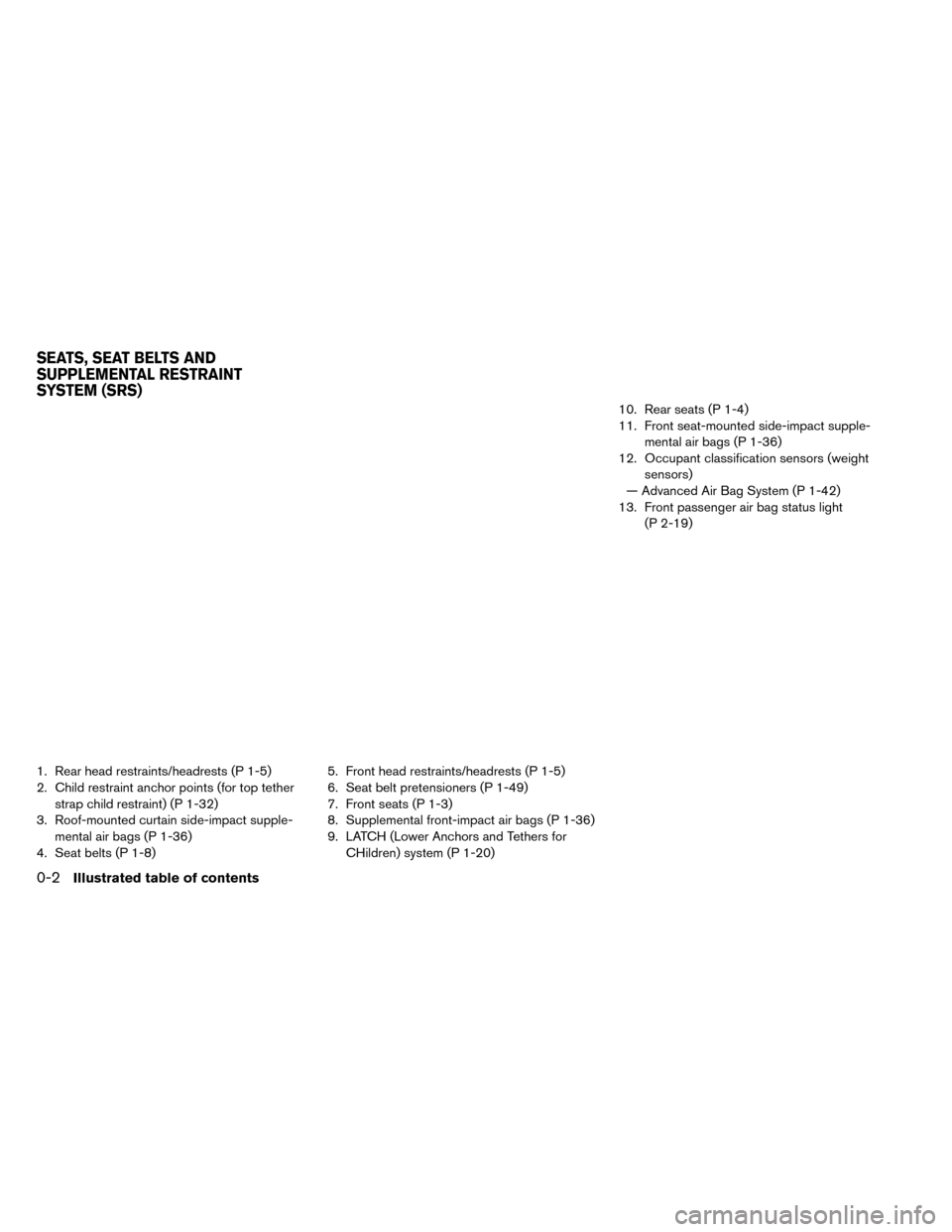
1. Rear head restraints/headrests (P 1-5)
2. Child restraint anchor points (for top tetherstrap child restraint) (P 1-32)
3. Roof-mounted curtain side-impact supple- mental air bags (P 1-36)
4. Seat belts (P 1-8) 5. Front head restraints/headrests (P 1-5)
6. Seat belt pretensioners (P 1-49)
7. Front seats (P 1-3)
8. Supplemental front-impact air bags (P 1-36)
9. LATCH (Lower Anchors and Tethers for
CHildren) system (P 1-20) 10. Rear seats (P 1-4)
11. Front seat-mounted side-impact supple-
mental air bags (P 1-36)
12. Occupant classification sensors (weight sensors)
— Advanced Air Bag System (P 1-42)
13. Front passenger air bag status light (P 2-19)
SEATS, SEAT BELTS AND
SUPPLEMENTAL RESTRAINT
SYSTEM (SRS)
0-2Illustrated table of contents
Page 62 of 412
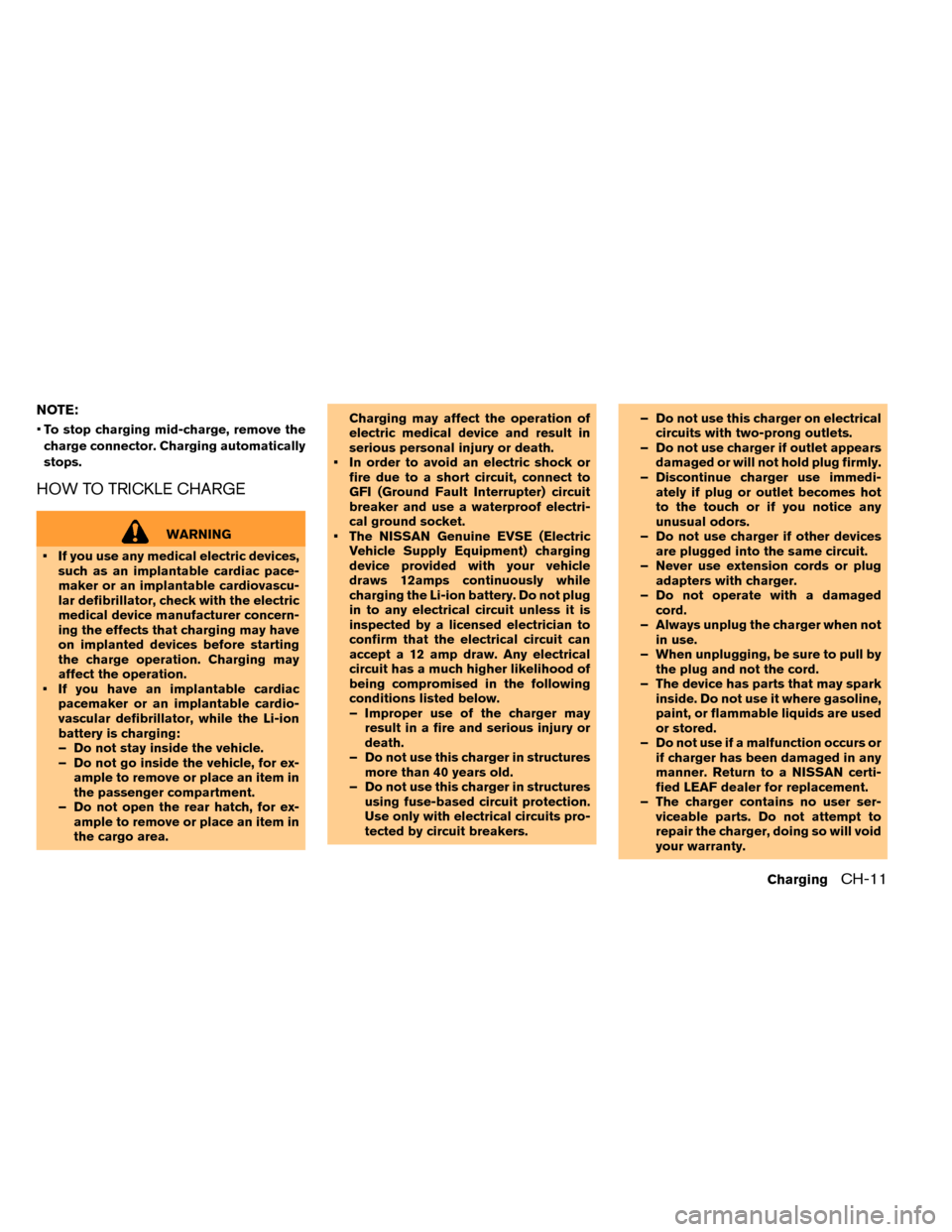
NOTE:
•To stop charging mid-charge, remove the
charge connector. Charging automatically
stops.
HOW TO TRICKLE CHARGE
WARNING
• If you use any medical electric devices, such as an implantable cardiac pace-
maker or an implantable cardiovascu-
lar defibrillator, check with the electric
medical device manufacturer concern-
ing the effects that charging may have
on implanted devices before starting
the charge operation. Charging may
affect the operation.
• If you have an implantable cardiac pacemaker or an implantable cardio-
vascular defibrillator, while the Li-ion
battery is charging:
– Do not stay inside the vehicle.
– Do not go inside the vehicle, for ex-ample to remove or place an item in
the passenger compartment.
– Do not open the rear hatch, for ex- ample to remove or place an item in
the cargo area. Charging may affect the operation of
electric medical device and result in
serious personal injury or death.
• In order to avoid an electric shock or fire due to a short circuit, connect to
GFI (Ground Fault Interrupter) circuit
breaker and use a waterproof electri-
cal ground socket.
• The NISSAN Genuine EVSE (Electric Vehicle Supply Equipment) charging
device provided with your vehicle
draws 12amps continuously while
charging the Li-ion battery. Do not plug
in to any electrical circuit unless it is
inspected by a licensed electrician to
confirm that the electrical circuit can
accept a 12 amp draw. Any electrical
circuit has a much higher likelihood of
being compromised in the following
conditions listed below.
– Improper use of the charger mayresult in a fire and serious injury or
death.
– Do not use this charger in structures more than 40 years old.
– Do not use this charger in structures using fuse-based circuit protection.
Use only with electrical circuits pro-
tected by circuit breakers. – Do not use this charger on electrical
circuits with two-prong outlets.
– Do not use charger if outlet appears damaged or will not hold plug firmly.
– Discontinue charger use immedi- ately if plug or outlet becomes hot
to the touch or if you notice any
unusual odors.
– Do not use charger if other devices are plugged into the same circuit.
– Never use extension cords or plug adapters with charger.
– Do not operate with a damaged cord.
– Always unplug the charger when not in use.
– When unplugging, be sure to pull by the plug and not the cord.
– The device has parts that may spark inside. Do not use it where gasoline,
paint, or flammable liquids are used
or stored.
– Do not use if a malfunction occurs or if charger has been damaged in any
manner. Return to a NISSAN certi-
fied LEAF dealer for replacement.
– The charger contains no user ser- viceable parts. Do not attempt to
repair the charger, doing so will void
your warranty.
ChargingCH-11
Page 88 of 412
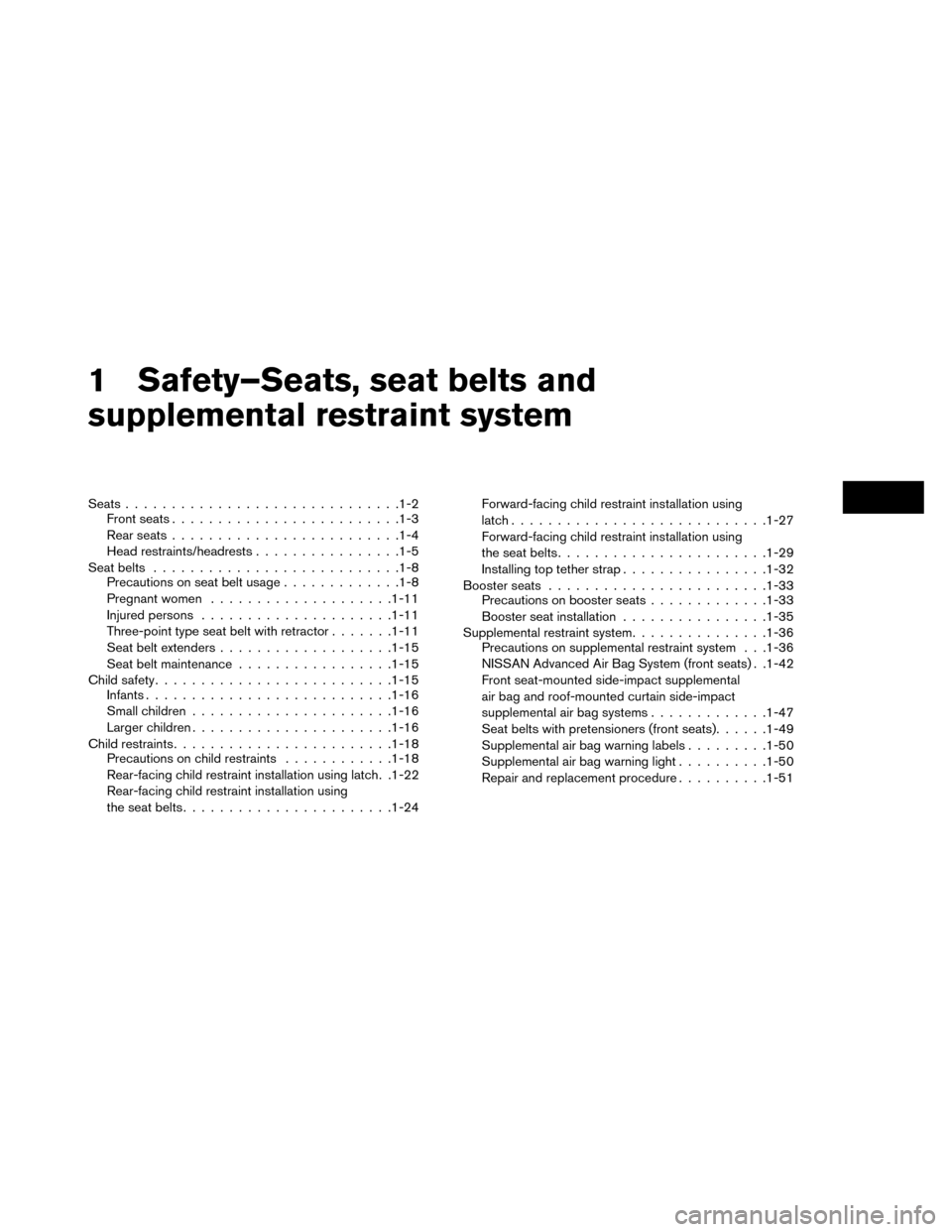
1 Safety–Seats, seat belts and
supplemental restraint system
Seats............................. .1-2
Front seats ........................ .1-3
Rear seats ........................ .1-4
Head restraints/headrests ................1-5
Seat belts .......................... .1-8
Precautions on seat belt usage .............1-8
Pregnant women ................... .1-11
Injured persons .................... .1-11
Three-point type seat belt with retractor .......1-11
Seat belt extenders .................. .1-15
Seat belt maintenance ................ .1-15
Child safety ......................... .1-15
Infants .......................... .1-16
Small children ..................... .1-16
Larger children ..................... .1-16
Child restraints ....................... .1-18
Precautions on child restraints ............1-18
Rear-facing child restraint installation using latch. .1-22
Rear-facing child restraint installation using
the seat belts ...................... .1-24Forward-facing child restraint installation using
latch
........................... .1-27
Forward-facing child restraint installation using
the seat belts ...................... .1-29
Installing top tether strap ................1-32
Booster seats ....................... .1-33
Precautions on booster seats .............1-33
Booster seat installation ................1-35
Supplemental restraint system ...............1-36
Precautions on supplemental restraint system . . .1-36
NISSAN Advanced Air Bag System (front seats) . .1-42
Front seat-mounted side-impact supplemental
air bag and roof-mounted curtain side-impact
supplemental air bag systems .............1-47
Seat belts with pretensioners (front seats) ......1-49
Supplemental air bag warning labels .........1-50
Supplemental air bag warning light ..........1-50
Repair and replacement procedure ..........1-51
Page 123 of 412
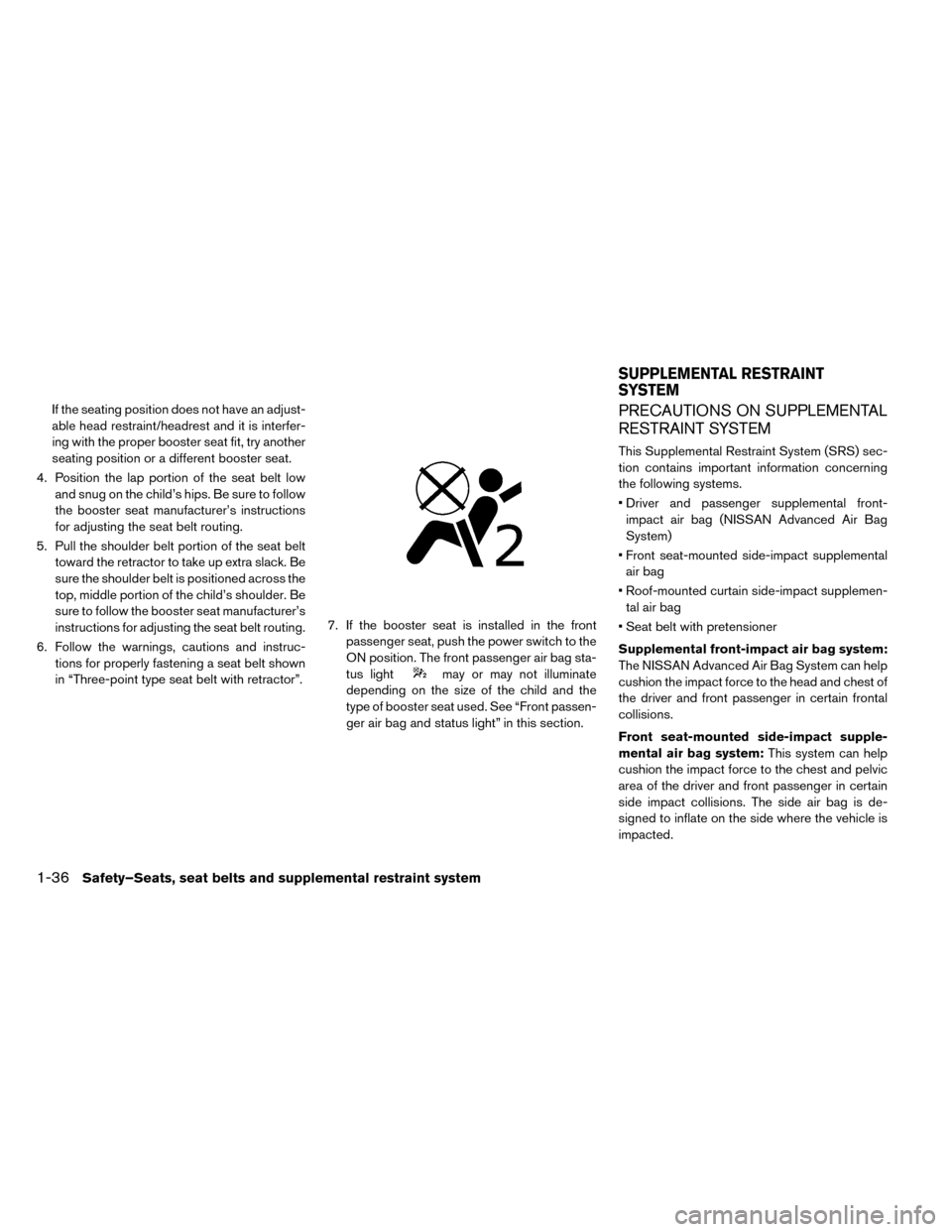
If the seating position does not have an adjust-
able head restraint/headrest and it is interfer-
ing with the proper booster seat fit, try another
seating position or a different booster seat.
4. Position the lap portion of the seat belt low and snug on the child’s hips. Be sure to follow
the booster seat manufacturer’s instructions
for adjusting the seat belt routing.
5. Pull the shoulder belt portion of the seat belt toward the retractor to take up extra slack. Be
sure the shoulder belt is positioned across the
top, middle portion of the child’s shoulder. Be
sure to follow the booster seat manufacturer’s
instructions for adjusting the seat belt routing.
6. Follow the warnings, cautions and instruc- tions for properly fastening a seat belt shown
in “Three-point type seat belt with retractor”. 7. If the booster seat is installed in the front
passenger seat, push the power switch to the
ON position. The front passenger air bag sta-
tus light
may or may not illuminate
depending on the size of the child and the
type of booster seat used. See “Front passen-
ger air bag and status light” in this section.
PRECAUTIONS ON SUPPLEMENTAL
RESTRAINT SYSTEM
This Supplemental Restraint System (SRS) sec-
tion contains important information concerning
the following systems.
• Driver and passenger supplemental front- impact air bag (NISSAN Advanced Air Bag
System)
• Front seat-mounted side-impact supplemental air bag
• Roof-mounted curtain side-impact supplemen- tal air bag
• Seat belt with pretensioner
Supplemental front-impact air bag system:
The NISSAN Advanced Air Bag System can help
cushion the impact force to the head and chest of
the driver and front passenger in certain frontal
collisions.
Front seat-mounted side-impact supple-
mental air bag system: This system can help
cushion the impact force to the chest and pelvic
area of the driver and front passenger in certain
side impact collisions. The side air bag is de-
signed to inflate on the side where the vehicle is
impacted.
SUPPLEMENTAL RESTRAINT
SYSTEM
1-36Safety–Seats, seat belts and supplemental restraint system
Page 124 of 412
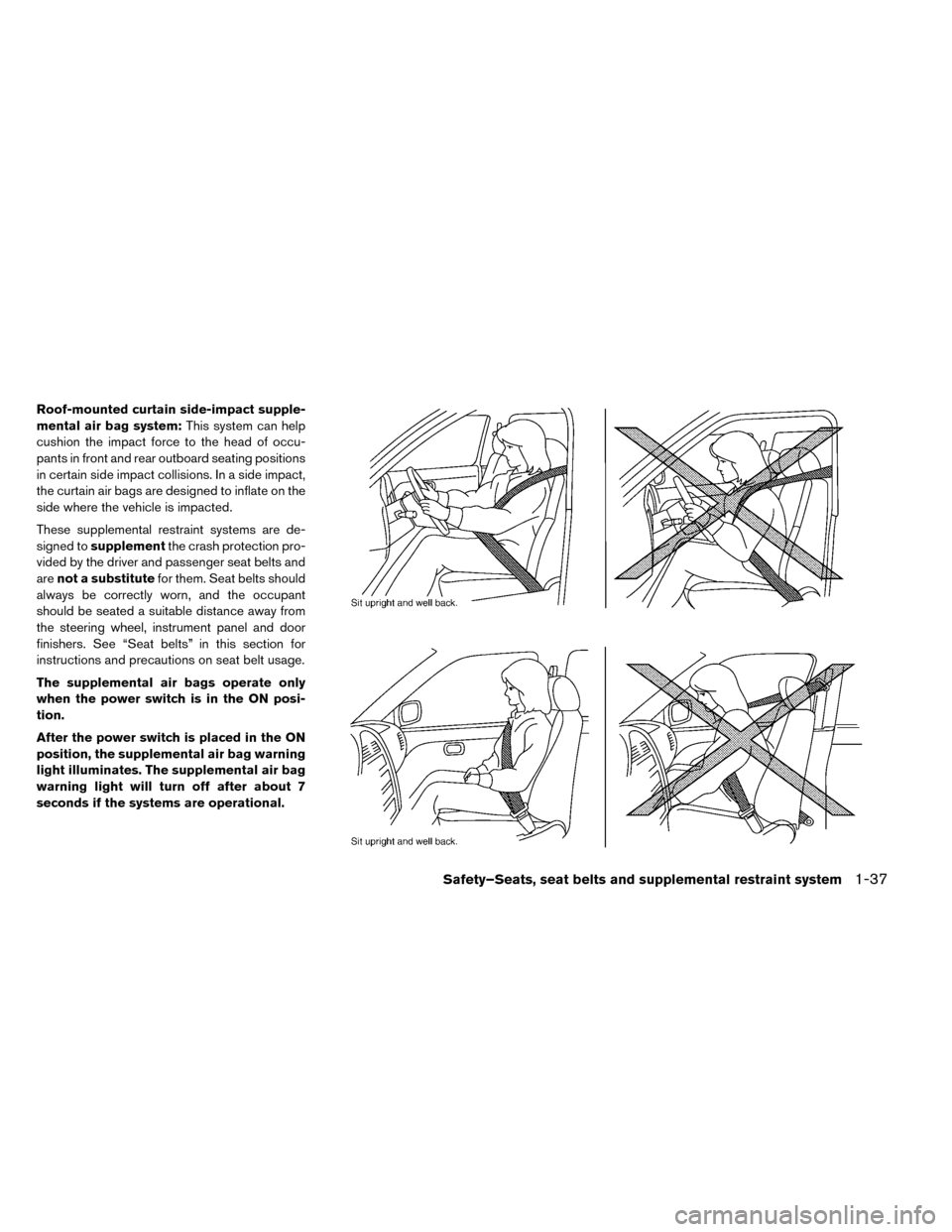
Roof-mounted curtain side-impact supple-
mental air bag system:This system can help
cushion the impact force to the head of occu-
pants in front and rear outboard seating positions
in certain side impact collisions. In a side impact,
the curtain air bags are designed to inflate on the
side where the vehicle is impacted.
These supplemental restraint systems are de-
signed to supplement the crash protection pro-
vided by the driver and passenger seat belts and
are not a substitute for them. Seat belts should
always be correctly worn, and the occupant
should be seated a suitable distance away from
the steering wheel, instrument panel and door
finishers. See “Seat belts” in this section for
instructions and precautions on seat belt usage.
The supplemental air bags operate only
when the power switch is in the ON posi-
tion.
After the power switch is placed in the ON
position, the supplemental air bag warning
light illuminates. The supplemental air bag
warning light will turn off after about 7
seconds if the systems are operational.
Safety–Seats, seat belts and supplemental restraint system1-37
Page 127 of 412
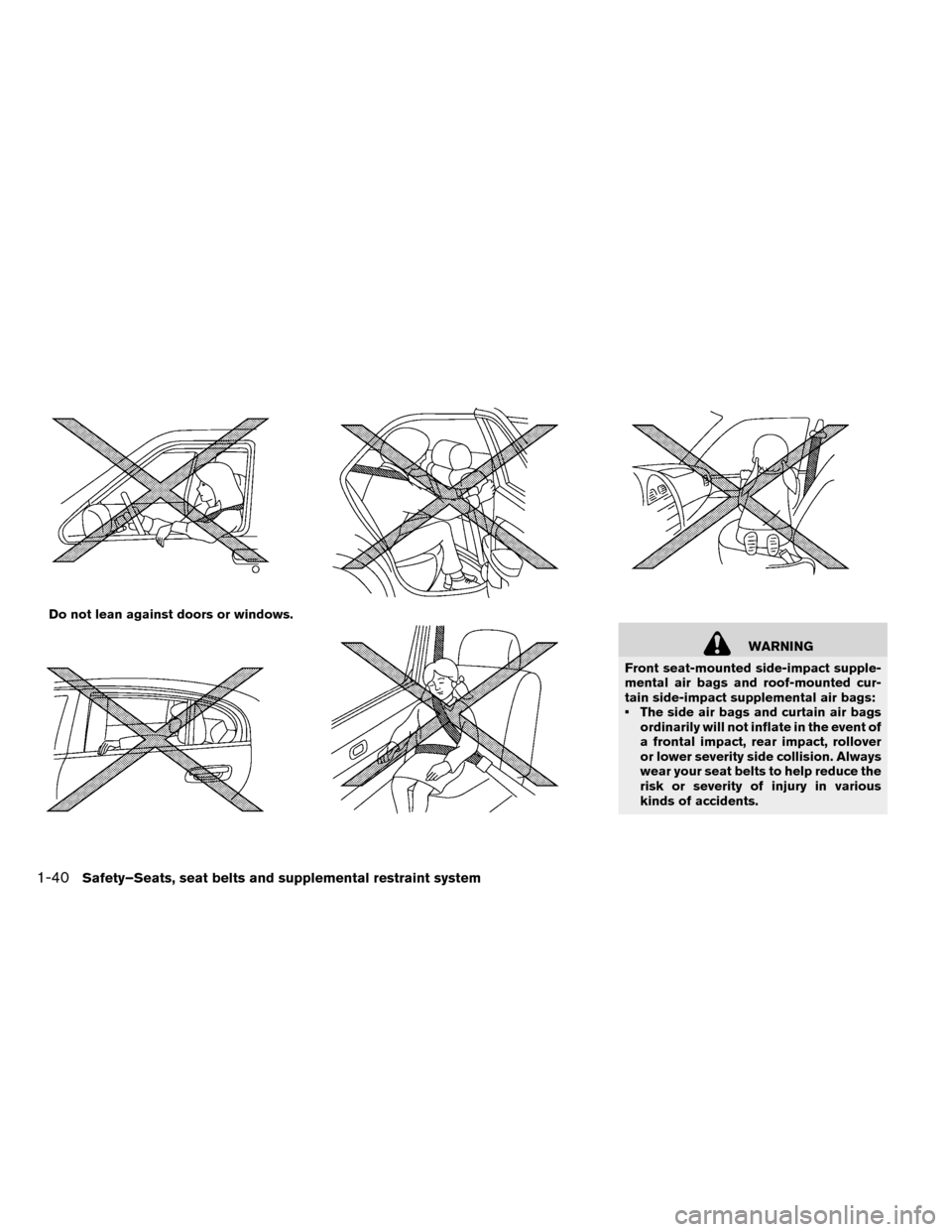
WARNING
Front seat-mounted side-impact supple-
mental air bags and roof-mounted cur-
tain side-impact supplemental air bags:
• The side air bags and curtain air bags ordinarily will not inflate in the event of
a frontal impact, rear impact, rollover
or lower severity side collision. Always
wear your seat belts to help reduce the
risk or severity of injury in various
kinds of accidents.
Do not lean against doors or windows.
1-40Safety–Seats, seat belts and supplemental restraint system
Page 128 of 412

• The seat belts, the side air bags andcurtain air bags are most effective
when you are sitting well back and
upright in the seat. The side air bag
and curtain air bag inflate with great
force. Do not allow anyone to place
their hand, leg or face near the side air
bag on the side of the seatback of the
front seat or near the side roof rails. Do
not allow anyone sitting in the front
seats or rear outboard seats to extend
their hand out of the window or lean
against the door. Some examples of
dangerous riding positions are shown
in the previous illustrations.
• When sitting in the rear seat, do not hold onto the seatback of the front
seat. If the side air bag inflates, you
may be seriously injured. Be especially
careful with children, who should al-
ways be properly restrained. Some ex-
amples of dangerous riding positions
are shown in the illustrations.
• Do not use seat covers on the front seatbacks. They may interfere with
side air bag inflation.
Safety–Seats, seat belts and supplemental restraint system1-41
Page 129 of 412
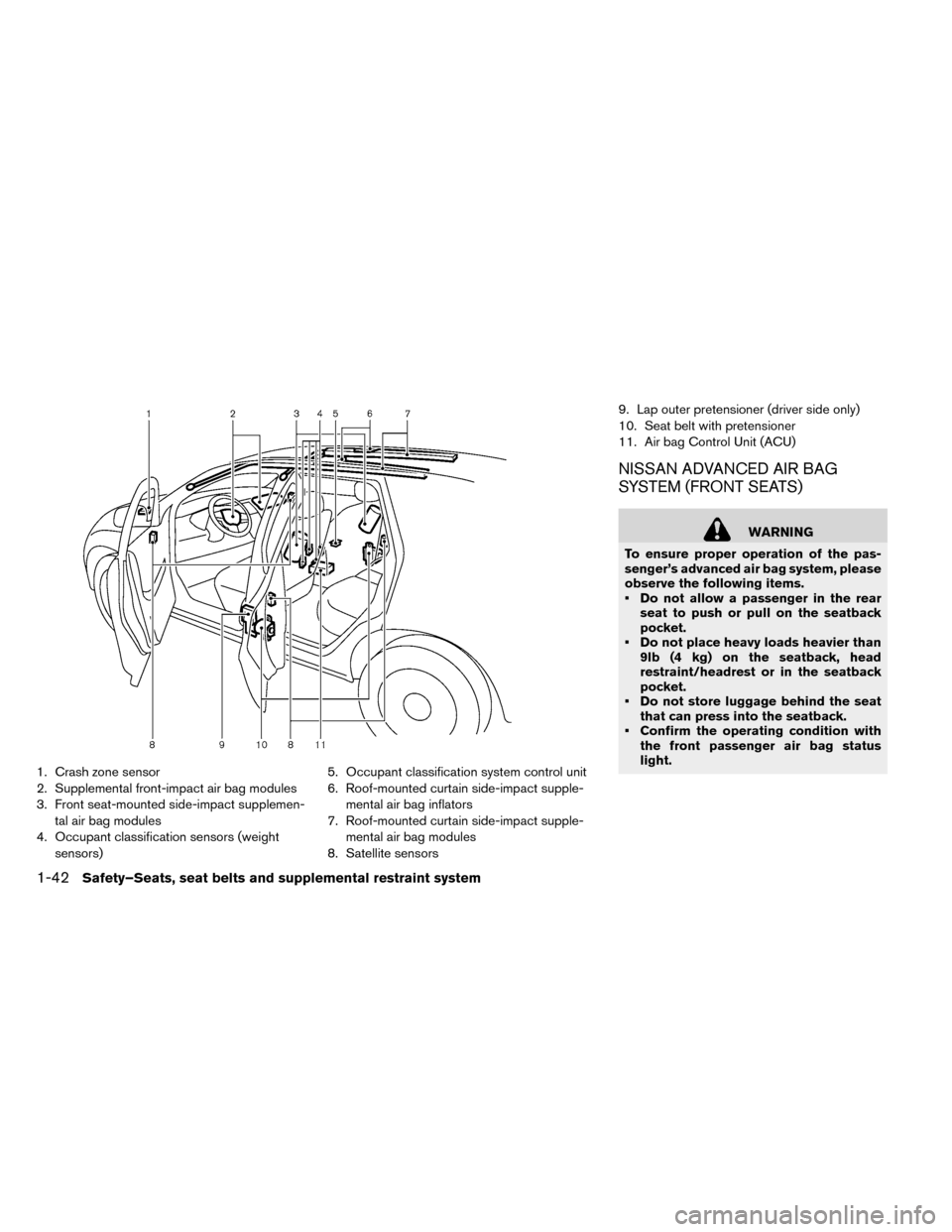
1. Crash zone sensor
2. Supplemental front-impact air bag modules
3. Front seat-mounted side-impact supplemen-tal air bag modules
4. Occupant classification sensors (weight sensors) 5. Occupant classification system control unit
6. Roof-mounted curtain side-impact supple-
mental air bag inflators
7. Roof-mounted curtain side-impact supple- mental air bag modules
8. Satellite sensors 9. Lap outer pretensioner (driver side only)
10. Seat belt with pretensioner
11. Air bag Control Unit (ACU)
NISSAN ADVANCED AIR BAG
SYSTEM (FRONT SEATS)
WARNING
To ensure proper operation of the pas-
senger’s advanced air bag system, please
observe the following items.
• Do not allow a passenger in the rear seat to push or pull on the seatback
pocket.
• Do not place heavy loads heavier than 9lb (4 kg) on the seatback, head
restraint/headrest or in the seatback
pocket.
• Do not store luggage behind the seat that can press into the seatback.
• Confirm the operating condition with the front passenger air bag status
light.
1-42Safety–Seats, seat belts and supplemental restraint system